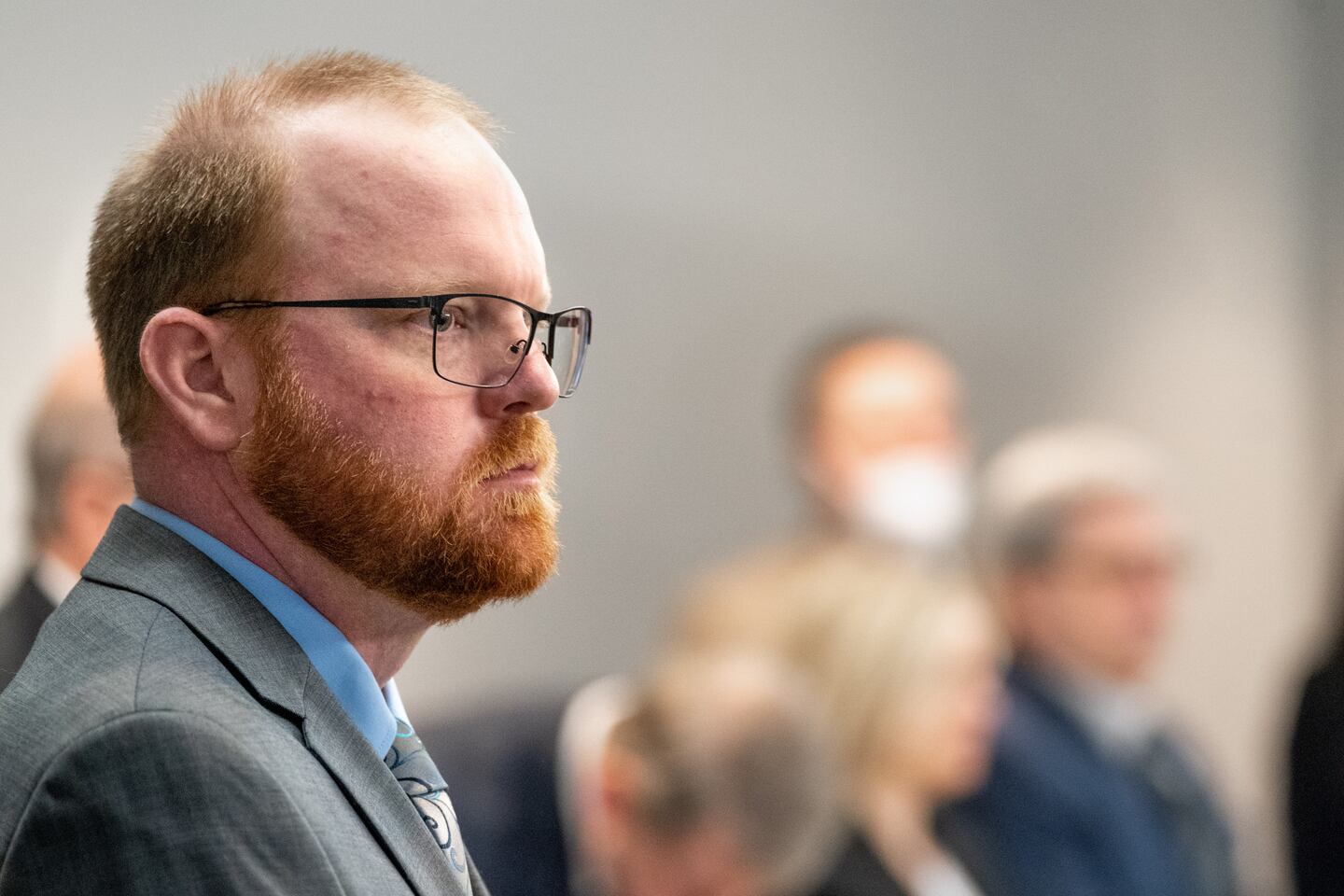4:03 PM:
As attorneys argue over the admission of statements made by Greg McMichael, Cooper-Jones appears to whisper something about the defense attorneys wasting time and how theses issues should have been worked out pre trial.
12:30 PM: Then-Ofcr. Minshew testifies about his bodycam video showing him talking to Roddie Bryan. Minshew asked Roddie Bryan if he was a passerby; he replied, “Not exactly.” He’d seen the black man run by, then the white truck in pursuit; he recognized none of them. Yet he yelled at the men in the truck, “Y’all got him?” and decided to join the chase. He tells Olivierre that Bryan didn’t ask the Black man if he was OK, or needed help.
"I'd cut him off pretty good now," said Roddie Bryan to Minshew, describing how he tried to block #AhmaudArbery. Jurors are furiously scribbling notes. Bryan told him Arbery had to stop to catch his breath & he blocked & cornered him during this chase; juror looks over at Bryan
— Veronica Waters (@MissVWaters) November 8, 2021
Bryan detailed for Minshew how he heard the men in the truck yelling, “Stop! What’d you do? What’d you steal? What’d you do?”
Bryan told him Arbery never said a word--even when he was close to the 25-year-old with his window down--and that Arbery once tried to open his truck’s door. He showed Minshew the place where Arbery’s fingerprints were on the door.
At one point, Bryan said, Arbery had to stop and catch his breath.
Minshew said Bryan told him that he blocked Arbery with his truck “five times” during the pursuit. That drew the attention of a juror, who looked over at Bryan as Minshew continued his testimony.
“Should I have been chasing him? I don’t know,” Bryan said to Minshew.
Under cross, defense attorney Kevin Gough took issue with the word “block” to describe what Bryan had done five times. He asked him if he realized that the word “block” was only used six times in the entire transcript, and that three of those times were describing how Bryan had circled the block.
Minshew said that Bryan used phrases like “corner” or “angled in” to describe his actions.
Gough said, “Roddie Bryan never expressed to you any intention on his part to physically injure Mr. Arbery in any way, did he?” Minshew said No.
11:10 AM: The State calls Ricky Minshew, who was a police officer the day Ahmaud Arbery was shot and killed. Minshew says he was responding to a 1:08 PM “suspicious Black male” call at 219 Satilla and was there within five minutes. As he drove in slowly, he heard “two pops...a couple of seconds apart” and knew the “booms” were either gunshots or fireworks.
When he turned a corner, he saw two white men flagging him down. He drove a bit up and parked his Glynn County PD patrol car. At the scene, he saw a Black man, lying in a pool of blood.
The Black male “appeared to be unresponsive...deceased...The blood had exceeded around his body. He was lying face down...in the puddle of blood.”
Prosecutor Larissa Olivierre asked Minshew if he heard anything.
“I heard, like, an agonal breathing. I’ve always heard it being called a death rattle,” said Minshew, who says he’s heard it before at a suicide scene and on the scenes of vehicular deaths.
Wanda Cooper-Jones says quietly on back row: "He didn't even go over to help." Bodycam transcript is admitted as evidence. #AhmaudArbery's mom left before any footage could be shown. Lawyers are now arguing over the footage being played @wsbradio pic.twitter.com/dIQtrbXnhc
— Veronica Waters (@MissVWaters) November 8, 2021
He says he didn’t render aid to Arbery as the two men--identified as the McMichaels--paced nearby because as the only policeman on the scene, he didn’t have another officer to watch his back so that he could switch to anything medical. Minshew has been criticized for not providing any first aid to Arbery. He also contended that he didn’t have the proper medical training and only had “a first aid pouch” in his patrol car.
The second officer to arrive, Glynn County Police Ofc. William Duggan, had pressed Arbery’s chest but testified Friday that with the massive blood loss and huge wounds, he knew “There was nothing I could do for him.”
Minshew also saw Travis McMichael’s shotgun on the ground nearby, with a “significant amount of blood” on it and spotted a silver revolver in the white Ford pickup.
Minshew saw blood on Travis McMichael’s hands, arms, head, and back of his neck. Jason Sheffield asked if it was “a tragic scene?” Minshew, replied, “Absolutely.” Was Travis McMichael under the influence of that trauma?, Sheffield wanted to know. State: Objection, speculation.
After some back-and-forth between the judge and defense about the question, Sheffield asks Minshew not to guess, but to describe what he observed: “And he appeared traumatized?”
“I would suspect that any person with a soul or a heart would be in shock,” said Minshew. Sheffield clarifies that he’s asking about Travis. Minshew says he saw McMichael “pacing back & forth.”
There were not any hand signals from Travis to Roddie Bryan to signal to the neighbor which way to go during the chase, either, Sheffield had Minshew confirm.
The day’s testimony begins with Sheila Ramos, Glynn County Police crime scene investigator. The jury paid close attention as she detailed the many photos she took--up-close, medium- , and long-range photos of the shooting scene, Ahmaud Arbery’s body, Travis McMichael’s gun, and spent shotgun shells. Several jurors squirmed in their seats as the first few photos of Arbery’s were shown. Wanda Cooper-Jones exhaled quietly as Ramos identified close-ups of gaping gunshot wounds to Arbery’s chest and wrist.
Travis McMichael appeared to be taking frequent notes himself.
Ramos testified that Arbery had nothing on him--no weapon, no phone, no tools of any type--when she documented his body and the crime scene. They identified him with fingerprints.
Defense attorney Jason Sheffield pointed out under cross-examination that Ramos did not know all of the streets on which the chase had unfolded, and that she didn’t canvass all of them.
At the time Ahmaud Arbery was shot, a shot from Travis McMichael’s shotgun pierced the window of a neighbor’s house and lodged in the wall. Inv. Ramos said they asked him if they could dig it out, but he was in the process of selling the home and didn’t want damage to the wall.
In reply to Jason Sheffield's questions, Inv. Ramos testifies that the firearm she collected had an empty/spent shell in the chamber, unejected. It would only be ejected if someone had re-racked Travis McMichael's shotgun. #AhmaudArbery @wsbradio pic.twitter.com/bl7uekC9EG
— Veronica Waters (@MissVWaters) November 8, 2021
Jurors play close attention to the photos: the location of the shotgun, shotgun shells, and bloodstained pavement in relation to #AhmaudArbery’s sheet-covered body. Close-ups of gunshot wounds to his wrist, chest. Travis McMichael appears to be taking notes of his own. @wsbradio pic.twitter.com/ULE9b3zwNM
— Veronica Waters (@MissVWaters) November 8, 2021
©2021 Cox Media Group









